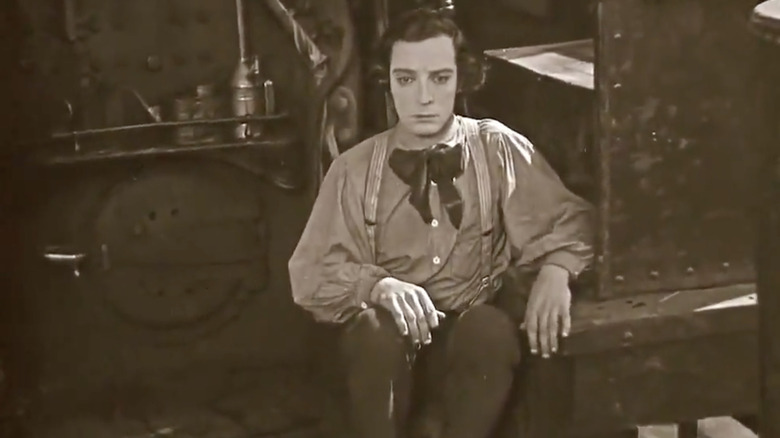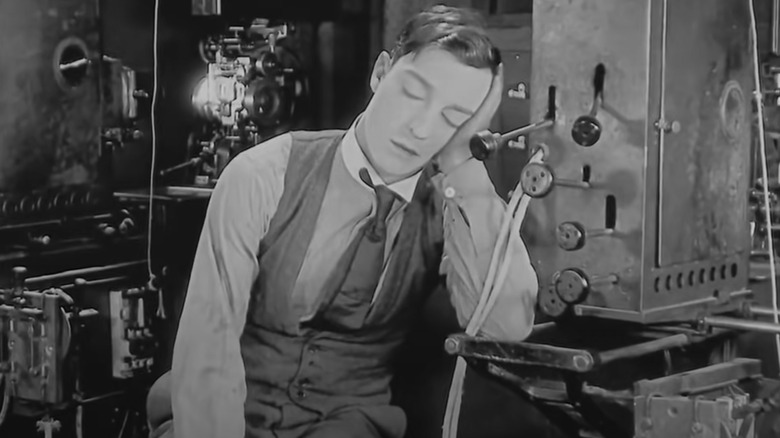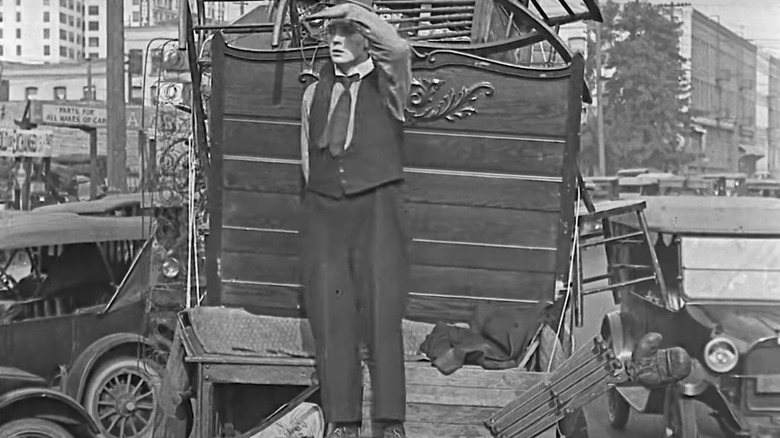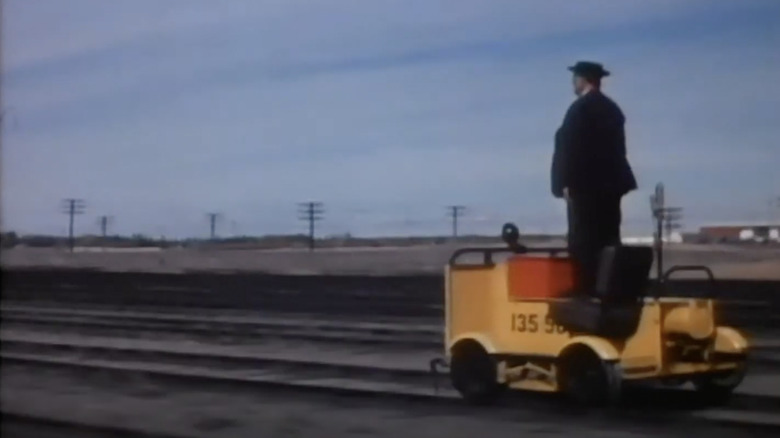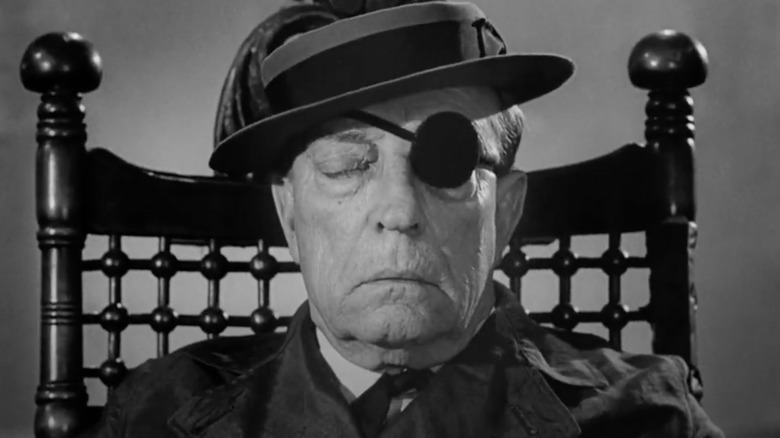How TV Breathed New Life Into Buster Keaton's Career
Silent film star Buster Keaton was bred for the spotlight. He was the son of traveling vaudeville performers, who were the stars and co-owners of the Keaton Houdini Medicine Show Company with legendary magician Harry Houdini. Keaton joined his parents' act at the tender age of three, and was frequently tossed around the stage by his father for comedic effect. Here, the actor learned how to take falls without suffering the bruises and breaks of mere mortals and perfected the sullen, deadpan expression that became his trademark. In 1917, Keaton moved his act from the stage to celluloid, and won over audiences with his amazing physical comedy.
Before stunts were managed with wires and CGI, Buster Keaton pulled off the most impressive physical gags audiences had ever seen, and for a while, they couldn't get enough of it. However, by the '30s, silent movies were quickly losing their popularity to sound films, called "talkies." Along with the silent film era, the golden age of Keaton, "the Great Stone Face," also came to an end. Until television offered him a new spotlight.
The man speaks
In the early '30s, when sound was the hot new thing film audiences craved, Keaton signed a deal with MGM to make some talkies. Much to his surprise, audiences enjoyed Keaton's first sound films, but he never did. He was a physical comedian, a man of action and spontaneity, and scripted films with clever dialogue didn't interest him. Years later, in a documentary called "Buster Keaton: A Hard Act to Follow," the comedian revealed that he was frustrated by the lack of creativity and unnecessary dialogue in his MGM films:
"They'd laugh their heads off at dialogue ... All your new writers are joke happy. They don't look for the action. They're looking for funny things to say."
In 1933, Keaton's unsatisfying contract with MGM was over, and his personal life was falling apart. He was struggling with alcoholism and depression, and his second marriage was ending. Keaton's finances were also in ruin and he filed for bankruptcy, which is possibly the only reason he continued making short films for Educational Pictures and Columbia Pictures for the rest of the '30s.
The Columbia shorts included more of his trademark physical comedy, but audiences grew tired of the same old routine, and the actor struggled to regain the creative freedom and satisfaction he experienced from his work in the 1920s.
The Buster Keaton Show
After a string of unsuccessful shorts, Keaton had small appearances in films like "Limelight," "That's the Spirit," "Boom in the Moon," and "Sunset Blvd," but he regained audience attention when he embraced television. Throughout the '50s, he appeared in episodes of popular British and American TV programs before getting his own show, "The Buster Keaton Show." Unfortunately, the program only lasted for six episodes, but he eventually found his stride with TV commercials.
Throughout the late '50s and early '60s, the comedian regularly appeared in American TV commercials that featured his famous stoic expression and, of course, the occasional physical gag. Unlike the MGM shorts, Keaton enjoyed making commercials because he could "do them quick and stay home ... and enjoy life."
Although it can be argued that his commercial work wasn't an artistic venture, it was the perfect way for the comedian to continue his passion for physical comedy and introduce his genius to a new generation. Keaton's appearances in popular television shows and commercials reignited audiences interest in his silent films and offered him an opportunity, once again, to share his artistic visions with a receptive audience.
According to "A Hard Act to Follow," with his newfound TV popularity, Keaton decided to rerelease his 1926 flop "The General" in Germany. 36 years after being universally panned by critics, the film finally earned the appreciation it deserved, and reinvigorated Keaton's film career. In 1965, English director Gerald Potterton approached him about a new idea for a film called "The Railrodder," which would feature Keaton's journey from one side of the United States to the other on a railway car. Keaton, never one to turn down a challenge, replied, "Sounds crazy. I'll do it."
'That's child's play'
For most of Keaton's life, he was known as a silent movie star or the funny man from commercials. But a behind-the-scenes look at the filming of "The Railrodder" gives a true glimpse into who Buster Keaton really was. During the making-of documentary "Buster Rides Again," Potterton decided it was too dangerous for the actor to pass over a 200 foot-tall bridge while standing on a railway car with his face hidden behind a huge map. Instead, he decided that Keaton should cross the bridge while doing his laundry, but the comedian wasn't satisfied with the safer gag, insisting:
"That is not dangerous. That's child's play, for the love of Mike ... I do worse things in my sleep than that. In my own backyard with a swimming pool I take more chances than that."
Keep in mind, Keaton was 69 years old at the time, an age when most people want to sit in their rocking chairs and take cat naps. But not Buster Keaton. He liked to live dangerously (even if he insisted the things he did weren't dangerous) and set his own limits. He never sacrificed a unique gag for a safer, less interesting one, and he didn't back down when he knew he was right. In the end, Keaton won, and pulled off the incredibly risky stunt without a hitch.
Next, despite his failing health from lung cancer, Keaton moved on to shoot the Samuel Beckett-scripted "Film."
Final Recognition
As mentioned in "A Hard Act to Follow," Keaton, and "Film," were invited to the Venice Film Festival, where a compilation of the actor's work had been shown the year before. When the legendary comedian arrived at the Festival, the audience greeted him with a spontaneous standing ovation, which he certainly deserved after 50 years of groundbreaking work.
Buster's artistic integrity and high standards for physical comedy led to a fall from grace into obscurity for many years, but his stubbornness paid off in the long run. He didn't always receive the kudos and respect he deserved in the past, but modern audiences aren't repeating that mistake. Today, Buster Keaton is widely recognized as not only one of the greatest silent film stars, but a comedic genius that dedicated his life to the art of the gag.
